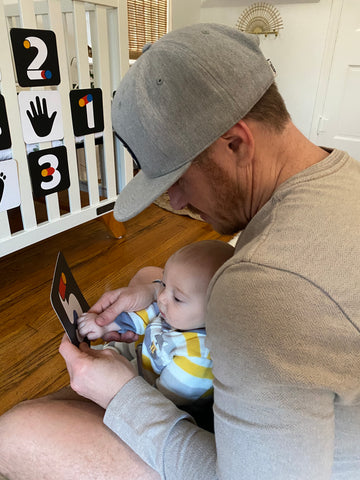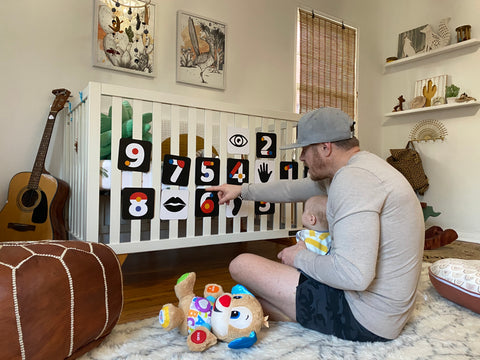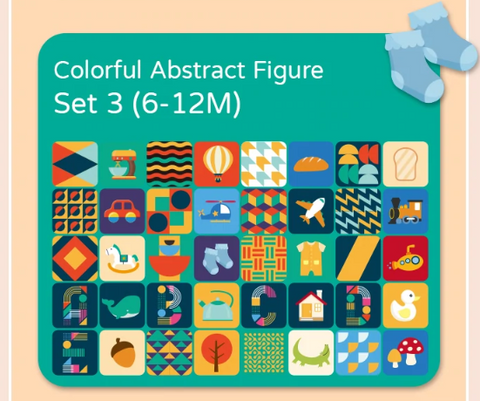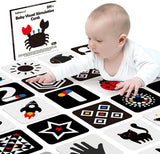Teach Your Baby and Toddlers with Flash Cards

How do you start flashcards for toddlers?
Flashcard learning is quite a popular way for parents or teachers introducing children to new words, images or concept. It’s an easy at-home teaching method because flashcards are portable, efficient and versatile.
We tend to take different approach to learning(teaching) at different ages. At a young age, children need more playful elements, let them learn through play. We can introduce them to children in fun and exciting ways!
How does the flashcard method work?
Before we learn how to use flashcards to teach children of different ages. We should know how the flashcard method work. So you can decide whether you should use flashcards and how to use it.

Benefits of using flashcards are aplenty:
* Stimulates the right brain
Flashcard is a useful medium to stimulate the right brain when they are flashed quickly to children. Children’s right brain development gets improved as they’re process the information.
* Develop instant memory ability
Children try to memorize information while the cards are being shown. Their instant memory ability is being develop.
* Practice fine motor skills
Fine motor skills are one of the important skills at a young age. Mastery of the small muscles in the hands is the precursor for good writing, cutting, and self-help skills. Some flashcard activities do double duty and help practice the fine motor skills as well!
* Expand General knowledge and vocabulary
From the contents of the flashcards, parents can expand the general knowledge and vocabulary of their children.
When to start using flash cards?
It's recommended to start using flash cards to teach your babies at the age of 3 months to 3 years old. It’s because that the child’s visual pathway is developed by 3 months old. The sooner you teach, the faster your child will learn. Due to their rapidly developing brains, they are able to learn to read in a more efficient manner than older children.
Although at this time, babies’ eyesight is blurred, they can focus on the words or images being presented. High contrast images, especially black and white images are ideal for visual stimulation, you can introduce flashcards into their everyday routine to develop the right brain memory of them and making learning a fun part of everyday play.
How To Use High Contrast Cards?
Below are 3 ways for your reference when you use high contrast flash cards. (Thanks IG@suttons_bookbag for these cute pics)
1. Prop him up by placing a nursing pillow or a towel (or other firm cushion) under his chest and arms. Show a high contrast card in his/her line of vision, and slowly move it upward to see if his/her head moves up.


2. Use your own body, like your Lap. Hold your baby across your lap and show the some high contrast images in front of your baby so she can see the images. You can help promote visual tracking by slowly moving an image back and forth horizontally in front of their face to help them practice following a moving object with their eyes. This is an important skill later for reading, writing, and hand-eye coordination.

3. As your baby gets older, you could use more complex high contrast images. Attaching them on the side of baby crib is a good idea. Talking to your baby when showing the cards is also recommended. It’s awkward to talk to someone who doesn’t talk back yet, but the research is clear - there’s a direct link between a child’s intelligence and the number of words spoken to them. Even though they can’t understand what you’re saying yet, their brain is laying the groundwork for acquiring language.
If your baby enjoys it, you could gradually increase increase the amount of time from 5 minutes to half an hour to a full hour.

By the time 6 months old, they are also generally believed to already have good colour vision. Their eyes are also capable of working together to form a three-dimensional view of the world and begin to see in-depth. You can expand the high contrast, simple black and white cards to cards with abstract shape with basic colors, then to concrete objects with various colors and to cards with numbers, alphabets, words etc.

How to introduce flashcards to kids?
The first thing that you need to remember before you start to introduce flashcards to your children is we need to keep the flashcard session fun and game-like. We must not push our children to read and put pressure on them.
It’s an all-age learning tool, even babies and toddler can “study” with them. We can use some motivators to help childresn loves flashcards seeion and participate more actively.
- Reward your child with their favorite physical activityand play with them
- Use healthy snacks as incentives when finish flashcards practice
- Encourage your child with free rewards, like hugss cheers for a job well done
You can also maintain a regular schedule of flashcard pratice by showing the flashcard 3-5 times a day or less. When it’s time for a diaper change or before/after feeding time, you can quickly flip through a set of cards.

Also we have some tips for you to teach your kids to read with flashcards:
- Start with simple words: You can start out with simple words that can be easily made into a image that baby can learn. Eye, hand, bus, nose,etc... 5 word card would be perfect for the beginning phase. Hold the card up so the baby can see it and say the word clearly. You could also point to what the word says.
- Repeat at least 3 times: It's recommended to repeat each word at least 3 times and point to the object as you say the word. Adding a pictorial clue offers a better visual stimulation in addition to the auditory learning. So don’t forget to say the word at least 3 times before moving on to the next flashcard as well as pointing to the pic or object to help them know what the word means.
- Set up a routine:Getting your child into a routine is essential for early learning study. Using the flashcards 3-5 times weekly and at the same time each day, so your child will get used to the early learning flashcards.
- Make it fun and be interactive: Make flashcard learning fun and enjoyable. For example, Bean Bag Toss: Layout flashcards face down up the floor. Ss toss the bean bag and identify the flashcard it lands on. During the flashcard game, you should be interactive and positive. Encourage your little one to be more interactive by helping them point to the correct object! And praise more when your little one doing great, it will help them feel confident and pic up on it quickly!
Education is important and by starting early with early learning flashcards, you are giving your child the necessary tools they'll need when starting school. Hope this article can help you with your little one’s early learning!
YOU MAY BE INTETESTED:
|
High Contrast Cards (0-6M) FOR AGE 0-6 MONTH |
|
|
Baby Visual Stimulation Card FOR AGE 0-6-12-36M |
 |
|
Flash Cards for Toddlers FOR 2-4 YEAR OLD |
 |
|
Water Painting Toddler Flash Card |
 |
|
Talking and Drawing Cards FOR 1-6 YEAR OLD |
 
|


